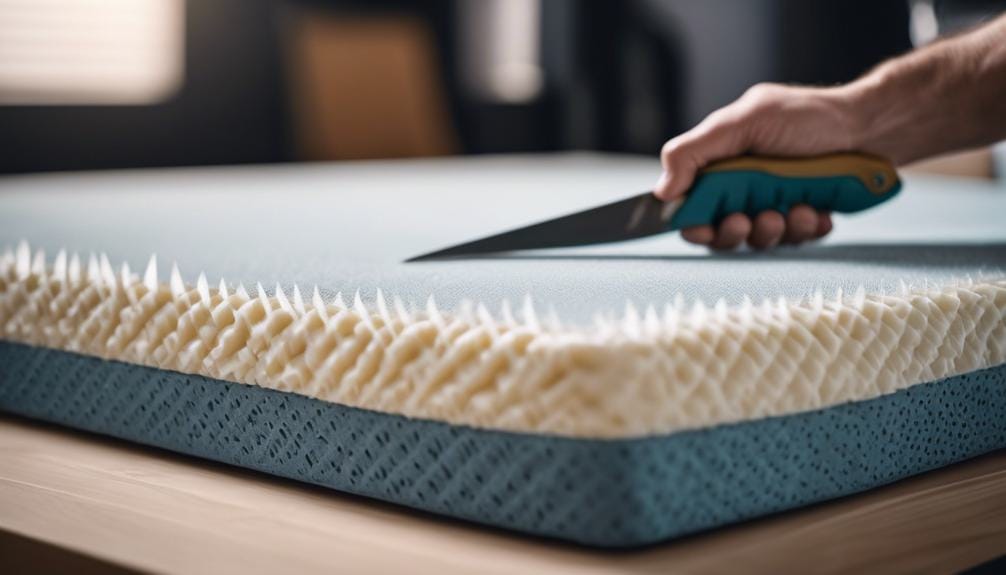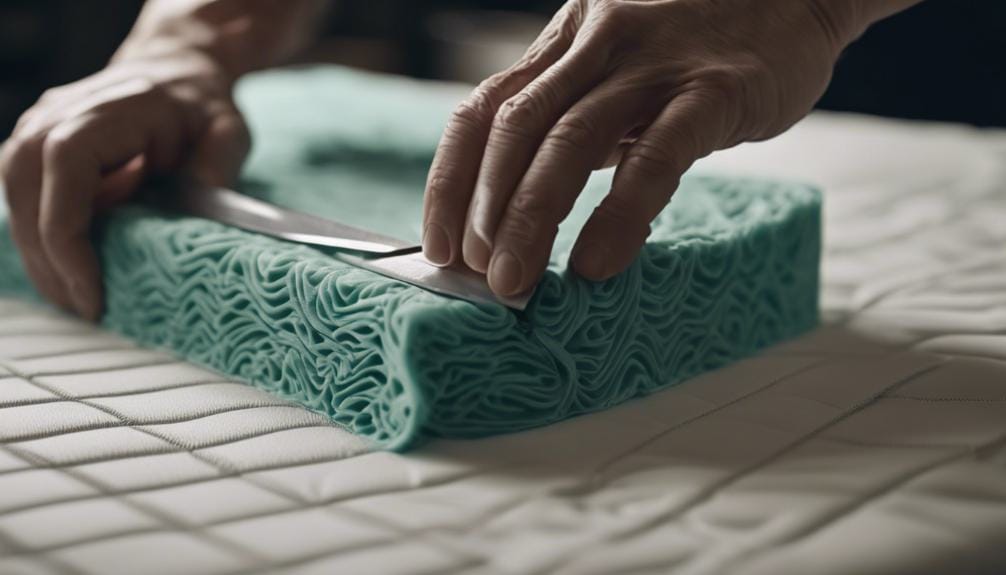How To Cut Latex Mattress Topper: Step-by-Step Guide
When cutting a latex mattress topper, measure with precision using a tape measure. Mark the desired size using a fabric marker, then choose the right cutting tool, like an electric knife for accurate cuts. Place the topper on a stable surface and cut along marked lines with a sharp utility knife. Guarantee clean cuts by smoothing rough edges with sandpaper. To prevent tears, gently handle the latex and maintain alignment of edges. Check for imperfections like tears or fraying edges, then flatten wrinkles for a smooth surface. Mastering these steps will secure a perfectly cut topper for your bed.
Proper Measurement Techniques
To cut a latex mattress topper correctly, first measure its width, length, and thickness with a tape measure. This step is crucial to make sure your cut is clean and the dimensions are accurate, which is necessary for the topper to fit perfectly.
Take careful measurements to avoid mistakes and ensure the topper matches your mattress size.
Marking the Desired Size
To mark your latex mattress topper accurately for cutting, use a fabric marker. This ensures clear lines, helping you to cut the topper correctly. First, measure meticulously to prevent any errors and to maintain the symmetry of your topper.
Planning and marking the dimensions and shape you want before cutting is crucial. For a more manageable cut, divide the mattress topper in half by marking it down the center. This step simplifies the cutting process and helps achieve a neat result.
Choosing the Right Cutting Tool

Consider using an electric knife for cutting your latex mattress topper, as it provides precise, clean cuts. This tool isn’t only designed specifically for materials like latex but also offers enhanced control and accuracy, which can be crucial when cutting to specific dimensions.
Additionally, an electric knife can significantly expedite the cutting process. This efficiency is due to the sharp, motorized blades that easily slice through latex compared to manual cutting methods, which are generally more time-consuming and labor-intensive.
Cutting Along Marked Lines
After marking the cutting lines on your latex mattress topper, place it on a stable, flat surface to prepare for cutting. Use a sharp utility knife to follow these lines carefully. Take your time to make sure your cuts are straight and clean, which will help preserve the shape and functionality of the topper.
After cutting, it’s important to let the topper fully expand to its original shape before using it. This step is crucial as it allows the material to settle properly, ensuring maximum comfort and effectiveness.
Ensuring Clean and Straight Cuts
To achieve clean and straight cuts on a latex mattress topper, it’s essential to use the right tools. A sharp utility knife or a rotary cutter is most effective. Here’s a straightforward guide to help you:
- Use a fabric marker to draw precise cutting lines. This step is crucial for accuracy.
- Place the topper on a stable, flat surface to keep it from moving.
- After cutting, you might notice some rough edges. Smooth these out with fine-grit sandpaper to achieve a more even finish.
- Take your time while cutting. A slow, steady pace helps prevent tears or uneven edges in the latex material.
Each step is designed to help maintain the integrity of the latex and ensure your modifications are both functional and aesthetically pleasing.
Preventing Tearing and Jagged Edges
To cut a latex mattress topper cleanly and avoid tearing or jagged edges, it’s essential to use the right tools. A sharp utility knife or a pair of heavy-duty scissors works best. Before you start cutting, use a fabric marker to draw precise lines where you’ll cut. This step is crucial for accuracy.
Place the topper on a stable, flat surface. This prevents the latex from moving and reduces the risk of uneven cuts. If you end up with jagged edges after cutting, lightly sand them with fine-grit sandpaper. This technique smooths out rough textures effectively. Remember, pulling or stretching the latex can damage the material, so handle it gently.
These tips are based on general best practices for cutting soft materials, ensuring clean, straight edges without damage to the material.
Maintaining Alignment Throughout

Maintain precise alignment of your latex mattress topper during the cutting process to ensure straight and even edges.
- Use a straight edge tool to align the edges of the topper before cutting. This method is widely used in the textile and manufacturing industries to achieve accuracy.
- Keep the topper straight and parallel to the cutting surface at all times. In precision cutting tasks, alignment with the work surface is critical for achieving desired outcomes.
- Adjust the position of the topper as necessary to maintain alignment during the cutting process. Frequent adjustments prevent misalignment, a common issue in manual cutting operations.
- Periodically check the alignment to avoid deviations in the cutting path. Regular verification is a best practice in many professional settings to ensure continuous accuracy.
Checking for Imperfections
Examine the latex mattress topper for tears, holes, or any uneven spots before you start cutting. Also, check the edges for any fraying or loose threads which might interfere with the cutting process. It’s important to make sure the topper is clean and free from any particles that could damage the cutting tools. Observe if there are any discolored or worn-out areas that could affect the shape after cutting. Flatten out any wrinkles or bumps to ensure the surface is even for cutting.
| Imperfection | Impact | Solution |
|---|---|---|
| Tears | Reduced durability | Repair with a latex patch |
| Holes | Weakened structure | Patch with latex material |
| Uneven surface | Inconsistent cuts | Use a topper press to flatten |
Each issue with the topper can significantly affect its performance and lifespan. For instance, tears and holes can compromise the structural integrity and durability of the mattress topper, as noted in materials science research. Using a latex patch or material can effectively restore this integrity. An uneven surface can lead to irregular cuts, impacting the usability and aesthetics of the topper. Pressing the topper to flatten it before cutting can prevent such issues, ensuring a clean, professional finish.
Frequently Asked Questions
Can I Cut a Latex Mattress Topper?
Yes, you can cut a latex mattress topper. Check the manufacturer guidelines first to avoid voiding the warranty. Use sharp tools like utility knives or scissors for clean cuts. Professional cutting services are an option for precise results.
What Is the Best Tool for Cutting Latex Foam?
For cutting latex foam, the best tool is an electric knife. It provides precise and smooth cuts, ensuring no damage to the material. The sharp blade effortlessly slices through the foam, making the process quicker and more accurate.
What’s the Best Way to Cut a Mattress Topper?
To cut a mattress topper, mark cutting lines accurately, use a sharp utility knife, secure it on a flat surface, and smooth rough edges with sandpaper. Avoid pulling or stretching the material for a clean finish.
Can I Cut My Latex Mattress in Half?
Yes, you can cut your latex mattress in half, but be cautious as it may void the warranty. Consider professional alternatives for customization. Guarantee precise measurements, safety measures, and maintaining mattress integrity while sewing new covers for each half.
Conclusion
To cut a latex mattress topper accurately, measure carefully and mark your lines before cutting. Use the right tools for a clean, straight cut that avoids tears.
Always double-check for any mistakes before making your final cuts. This ensures your mattress topper fits perfectly.
So, go ahead and cut with confidence!
